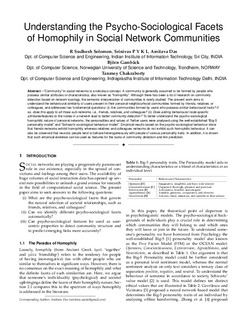| dc.contributor.author | Solomon, R Sudhesh | |
| dc.contributor.author | Srinivas, PYKL | |
| dc.contributor.author | Das, Amitava | |
| dc.contributor.author | Gambäck, Björn | |
| dc.contributor.author | Chakraborty, Tanmoy | |
| dc.date.accessioned | 2019-11-07T09:02:56Z | |
| dc.date.available | 2019-11-07T09:02:56Z | |
| dc.date.created | 2019-11-06T15:24:57Z | |
| dc.date.issued | 2019 | |
| dc.identifier.citation | IEEE Computational Intelligence Magazine. 2019, 14 (2), 28-40. | nb_NO |
| dc.identifier.issn | 1556-603X | |
| dc.identifier.uri | http://hdl.handle.net/11250/2627103 | |
| dc.description.abstract | "Community" in social networks is a nebulous concept. A community is generally assumed to be formed by people who possess similar attributes or characteristics, also known as "homophily". Although there has been a lot of research on community detection based on network topology, the semantic interpretation of communities is rarely studied. The present work aims to understand the behavioral similarity of users present in their personal neighborhood communities formed by friends, relatives, or colleagues, and addresses two fundamental questions: (i) Are communities formed by users who possess similar behavioral traits? If so, does this apply to all those sub-networks, i.e., friends, relatives, and colleagues? (ii) Does adding behavioral node-specific attributes/features to the nodes in a network lead to better community detection? To better understand the psycho-sociological homophilic nature of personal networks, the personalities and values of Twitter users were analyzed using the well-established "Big-5 personality model" and "Schwartz sociological behavior model". Empirical results based on the psychosociological behavior show that friends networks exhibit homophily, whereas relatives and colleagues networks do not exhibit such homophilic behavior. It can also be observed that neurotic people tend to behave heterogeneously with people of various personality traits. In addition, it is shown that such empirical evidence can be used as features for the tasks of community detection and link prediction. | nb_NO |
| dc.language.iso | eng | nb_NO |
| dc.publisher | Institute of Electrical and Electronics Engineers (IEEE) | nb_NO |
| dc.title | Understanding the Psycho-Sociological Facets of Homophily in Social Network Communities | nb_NO |
| dc.type | Journal article | nb_NO |
| dc.type | Peer reviewed | nb_NO |
| dc.description.version | acceptedVersion | nb_NO |
| dc.source.pagenumber | 28-40 | nb_NO |
| dc.source.volume | 14 | nb_NO |
| dc.source.journal | IEEE Computational Intelligence Magazine | nb_NO |
| dc.source.issue | 2 | nb_NO |
| dc.identifier.doi | 10.1109/MCI.2019.2901084 | |
| dc.identifier.cristin | 1744647 | |
| dc.description.localcode | © 2019 IEEE. Personal use of this material is permitted. Permission from IEEE must be obtained for all other uses, in any current or future media, including reprinting/republishing this material for advertising or promotional purposes, creating new collective works, for resale or redistribution to servers or lists, or reuse of any copyrighted component of this work in other works. | nb_NO |
| cristin.unitcode | 194,63,10,0 | |
| cristin.unitname | Institutt for datateknologi og informatikk | |
| cristin.ispublished | true | |
| cristin.fulltext | postprint | |
| cristin.qualitycode | 1 | |
